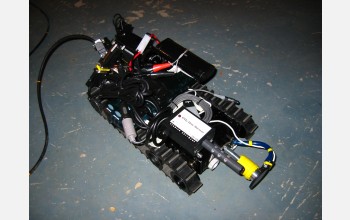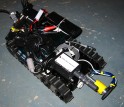News Release 03-020
Workshop Prepares Robotics Researchers to Participate in Emergency Response Training
February 11, 2003
This material is available primarily for archival purposes. Telephone numbers or other contact information may be out of date; please see current contact information at media contacts.
A platoon of robotics researchers, usually more comfortable with laptops and lab equipment, will don hard hats and steel-toed boots at a one-day workshop to prepare them to work in the field with professional emergency response teams. The Feb. 18 workshop at the University of South Florida (USF) will provide the essential training they need to participate in a summer exercise that will use robots in realistic search-and-rescue drills.
The workshop will be led by computer scientist Robin Murphy, director of USF's Center for Robot-Assisted Search and Rescue (CRASAR), and is supported by the National Science Foundation (NSF) through the Rescue Robots for Research and Response (R4) project. The workshop is being held in conjunction with the Feb. 19-20 International Workshop on Safety, Security, and Rescue Robotics (SSRR), sponsored by the IEEE Robotics and Automation Society and the Army Research Office and hosted by CRASAR.
"It's important to get computer scientists into the field so they can get a real-world perspective on human-machine interaction," Murphy said. "I expect to see scientists looking lost without their laptops, eating MREs [military 'meals ready-to-eat'] for lunch and wearing steel-toed boots." The Feb. 18 workshop aims to introduce the experience of search-and-rescue fieldwork to robotics researchers who often spend much of their time in a laboratory.
CRASAR is internationally recognized as a leader in the use of robots for search-and-rescue operations. Last December, CRASAR conducted the first use of rescue robots in a joint international exercise in Johannesburg, South Africa, and has been added to the United Nations registry as the only international response team specializing in rescue robots.
CRASAR maintains a self-sufficient response team with a cache of robots ready for rapid deployment within 4 hours, nationally and internationally. CRASAR is also working with the Federal Emergency Management Agency's (FEMA) Urban Search and Rescue Task Forces, the elite "special forces" of the U.S. emergency response system.
Representatives of FEMA's Indiana Task Force 1 will be participating in the first day of the SSRR workshop, along with robotics users specializing in airport security, explosive ordnance, mining disasters, medicine and chemical, biological and radiological events. The SSRR workshop's second day will feature robot search-and-rescue demonstrations at a rubble pile on the USF campus.
The goal of the SSRR workshop is to set a research agenda and vision for robotic urban search and rescue, as well as form a scientific community. Robots from all over the world will be present, including models used at the World Trade Center site, and innovative platforms such as snake-like robots.
Robotics and automation are showing tremendous potential for security, safety and rescue applications. Robots can extend the reach and senses of rescue workers, especially in confined spaces, which can help locate trapped survivors more quickly and safely.
"CRASAR's rescue robots represent a major success story from NSF support for leading-edge infrastructure and instrumentation and demonstrate the important impact that such activities can have today," said NSF program officer Rita Rodriguez.
For those robotics researchers who complete the Feb. 18 workshop, CRASAR is hosting a summer institute in July. The institute is designed to allow scientists to watch and learn how robots are used successfully and not so successfully in realistic search-and-rescue operations. The scientists will participate alongside professional emergency response teams in the "high-fidelity" drills in order to get a real-world perspective on human-robot interaction.
Robots will be demonstrated during SSRR on the University of South Florida campus in Tampa, Florida, on Feb. 20 from 10:30 a.m. to 2 p.m. Demonstrations are open to the press. Activities on Feb. 18 run from 8 a.m. to 8 p.m. and will be conducted at USF and at the Florida Task Force-3 training site; please call Robin Murphy at 813-974-3652 in advance to make arrangements.
-NSF-
-
View Video
Inuktun Services Ltd. robot carrying water tube.
Credit and Larger Version
Media Contacts
David Hart, NSF, (703) 292-8070, email: dhart@nsf.gov
Program Contacts
Rita V. Rodriguez, NSF, (703) 292-8950, email: rrodrigu@nsf.gov
Related Websites
CRASAR: http://www.crasar.org/
B-roll and photos available. Samples at: http://www.csee.usf.edu/robotics/crasar/Press/
The U.S. National Science Foundation propels the nation forward by advancing fundamental research in all fields of science and engineering. NSF supports research and people by providing facilities, instruments and funding to support their ingenuity and sustain the U.S. as a global leader in research and innovation. With a fiscal year 2023 budget of $9.5 billion, NSF funds reach all 50 states through grants to nearly 2,000 colleges, universities and institutions. Each year, NSF receives more than 40,000 competitive proposals and makes about 11,000 new awards. Those awards include support for cooperative research with industry, Arctic and Antarctic research and operations, and U.S. participation in international scientific efforts.
Connect with us online
NSF website: nsf.gov
NSF News: nsf.gov/news
For News Media: nsf.gov/news/newsroom
Statistics: nsf.gov/statistics/
Awards database: nsf.gov/awardsearch/
Follow us on social
Twitter: twitter.com/NSF
Facebook: facebook.com/US.NSF
Instagram: instagram.com/nsfgov




